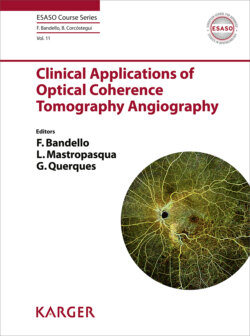Читать книгу Clinical Applications of Optical Coherence Tomography Angiography - Группа авторов - Страница 11
На сайте Литреса книга снята с продажи.
Abstract
ОглавлениеDry age-related macular degeneration (AMD) is characterized by changes in the outer retina, retinal pigment epithelium (RPE), and choroid. Optical coherence tomography angiography (OCTA) has proven instrumental in analyzing these changes and further understanding the pathogenesis of AMD. Early and intermediate AMD have been shown to be associated with choroidal thinning, choriocapillaris (CC) alterations under drusen, and intraretinal vascular depletion. OCTA of geographic atrophy (GA), the late stage of dry AMD, has demonstrated CC loss under the lesion itself and decreased CC flow speeds around the area of atrophy, suggesting a key role of the CC in GA pathogenesis. Much still remains to be understood about dry AMD, with an ongoing debate of whether initial changes occur in the CC, RPE, or photoreceptor layer. By allowing investigation of retinal and choroidal vascular flow changes associated with dry AMD, OCTA may pave the way for improved prediction, detection, and monitoring of dry AMD disease progression.
© 2020 S. Karger AG, Basel
Age-related macular degeneration (AMD) is the leading cause of blindness in the elderly population in developed countries, and accounts for nearly 8.7% of blindness worldwide [1]. It is estimated that 30–50 million people are affected by AMD around the world, a number only anticipated to increase in the coming years.
The pathogenesis of AMD has been linked to a multitude of factors, including increasing age, oxidative stress, inflammation, genetics, mitochondrial factors, ischemia, and environmental contributors [2, 3]. AMD is characterized by angiogenesis, drusen formation, and local complementary and inflammatory responses [4]. The inciting event of dry AMD, however, still remains to be determined. Dry AMD involves changes in the photoreceptor cells, retinal pigment epithelium (RPE), and choroid, but it is still unclear where the initial change takes place. Theories suggest that there may be a primary dysfunction of the photoreceptor cells, or that a defective RPE may lead to photoreceptor cell damage. Fairly recently, however, choroidal changes have also been discovered to be associated with the occurrence of dry AMD, an area that is still being explored with great interest [5–9].
